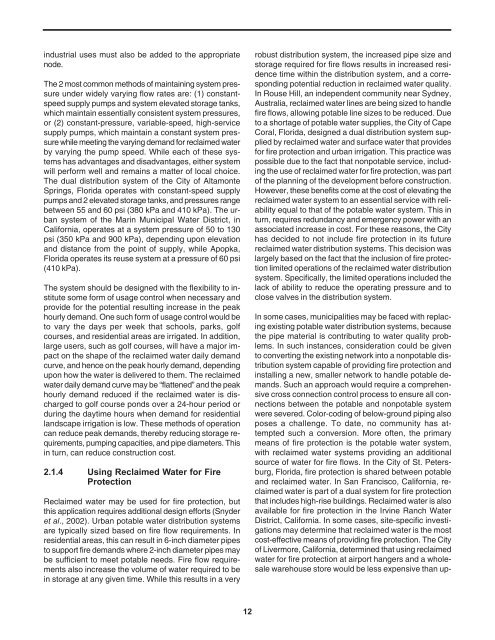o_19f3m1n7k170b14e9u0oqipgu4a.pdf
Create successful ePaper yourself
Turn your PDF publications into a flip-book with our unique Google optimized e-Paper software.
industrial uses must also be added to the appropriate<br />
node.<br />
The 2 most common methods of maintaining system pressure<br />
under widely varying flow rates are: (1) constantspeed<br />
supply pumps and system elevated storage tanks,<br />
which maintain essentially consistent system pressures,<br />
or (2) constant-pressure, variable-speed, high-service<br />
supply pumps, which maintain a constant system pressure<br />
while meeting the varying demand for reclaimed water<br />
by varying the pump speed. While each of these systems<br />
has advantages and disadvantages, either system<br />
will perform well and remains a matter of local choice.<br />
The dual distribution system of the City of Altamonte<br />
Springs, Florida operates with constant-speed supply<br />
pumps and 2 elevated storage tanks, and pressures range<br />
between 55 and 60 psi (380 kPa and 410 kPa). The urban<br />
system of the Marin Municipal Water District, in<br />
California, operates at a system pressure of 50 to 130<br />
psi (350 kPa and 900 kPa), depending upon elevation<br />
and distance from the point of supply, while Apopka,<br />
Florida operates its reuse system at a pressure of 60 psi<br />
(410 kPa).<br />
The system should be designed with the flexibility to institute<br />
some form of usage control when necessary and<br />
provide for the potential resulting increase in the peak<br />
hourly demand. One such form of usage control would be<br />
to vary the days per week that schools, parks, golf<br />
courses, and residential areas are irrigated. In addition,<br />
large users, such as golf courses, will have a major impact<br />
on the shape of the reclaimed water daily demand<br />
curve, and hence on the peak hourly demand, depending<br />
upon how the water is delivered to them. The reclaimed<br />
water daily demand curve may be “flattened” and the peak<br />
hourly demand reduced if the reclaimed water is discharged<br />
to golf course ponds over a 24-hour period or<br />
during the daytime hours when demand for residential<br />
landscape irrigation is low. These methods of operation<br />
can reduce peak demands, thereby reducing storage requirements,<br />
pumping capacities, and pipe diameters. This<br />
in turn, can reduce construction cost.<br />
2.1.4 Using Reclaimed Water for Fire<br />
Protection<br />
Reclaimed water may be used for fire protection, but<br />
this application requires additional design efforts (Snyder<br />
et al., 2002). Urban potable water distribution systems<br />
are typically sized based on fire flow requirements. In<br />
residential areas, this can result in 6-inch diameter pipes<br />
to support fire demands where 2-inch diameter pipes may<br />
be sufficient to meet potable needs. Fire flow requirements<br />
also increase the volume of water required to be<br />
in storage at any given time. While this results in a very<br />
robust distribution system, the increased pipe size and<br />
storage required for fire flows results in increased residence<br />
time within the distribution system, and a corresponding<br />
potential reduction in reclaimed water quality.<br />
In Rouse Hill, an independent community near Sydney,<br />
Australia, reclaimed water lines are being sized to handle<br />
fire flows, allowing potable line sizes to be reduced. Due<br />
to a shortage of potable water supplies, the City of Cape<br />
Coral, Florida, designed a dual distribution system supplied<br />
by reclaimed water and surface water that provides<br />
for fire protection and urban irrigation. This practice was<br />
possible due to the fact that nonpotable service, including<br />
the use of reclaimed water for fire protection, was part<br />
of the planning of the development before construction.<br />
However, these benefits come at the cost of elevating the<br />
reclaimed water system to an essential service with reliability<br />
equal to that of the potable water system. This in<br />
turn, requires redundancy and emergency power with an<br />
associated increase in cost. For these reasons, the City<br />
has decided to not include fire protection in its future<br />
reclaimed water distribution systems. This decision was<br />
largely based on the fact that the inclusion of fire protection<br />
limited operations of the reclaimed water distribution<br />
system. Specifically, the limited operations included the<br />
lack of ability to reduce the operating pressure and to<br />
close valves in the distribution system.<br />
In some cases, municipalities may be faced with replacing<br />
existing potable water distribution systems, because<br />
the pipe material is contributing to water quality problems.<br />
In such instances, consideration could be given<br />
to converting the existing network into a nonpotable distribution<br />
system capable of providing fire protection and<br />
installing a new, smaller network to handle potable demands.<br />
Such an approach would require a comprehensive<br />
cross connection control process to ensure all connections<br />
between the potable and nonpotable system<br />
were severed. Color-coding of below-ground piping also<br />
poses a challenge. To date, no community has attempted<br />
such a conversion. More often, the primary<br />
means of fire protection is the potable water system,<br />
with reclaimed water systems providing an additional<br />
source of water for fire flows. In the City of St. Petersburg,<br />
Florida, fire protection is shared between potable<br />
and reclaimed water. In San Francisco, California, reclaimed<br />
water is part of a dual system for fire protection<br />
that includes high-rise buildings. Reclaimed water is also<br />
available for fire protection in the Irvine Ranch Water<br />
District, California. In some cases, site-specific investigations<br />
may determine that reclaimed water is the most<br />
cost-effective means of providing fire protection. The City<br />
of Livermore, California, determined that using reclaimed<br />
water for fire protection at airport hangers and a wholesale<br />
warehouse store would be less expensive than up<br />
12



